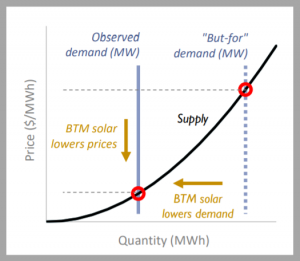So you’re thinking about going solar. Or perhaps you’ve already taken the step of installing a few panels. But now you’re questioning whether your decision is making an economic or environmental difference for the nation at large. I mean, what role can your small-scale solar array play in aiding the shift from fossil fuels to renewables? The answer is, a lot.
To understand the benefits of small-scale solar, we must first define “small-scale” systems. In technical jargon, small-scale solar systems are called “behind-the-meter” (BTM) systems. BTM systems are small (generating less than 5 MW) and do not participate in energy markets. Thus, residential solar systems, which use solar-generated energy before feeding excess back to the grid, qualify as BTM systems. Oppositely, “front-of-the-meter” (FTM) systems are large, often standalone systems that generate electricity for paying customers.
Now let’s dive into what BTM systems can do. Between 2014 and 2019, BTM solar produced 8,600 GWh of electricity. That’s enough electricity to power more than 1 million New England households for a year. Let’s determine what this means for the economy, the environment, and public health.
First, BTM solar systems reduce electricity demand from fossil fuel-fired power plants, saving utility payers $1.1 billion.
We could look at these savings in two ways: load impact and price impact.
Load impact, according to Synapse, is the “benefit associated with the reduction in the quantity of electricity purchased.” Reduced electricity demand averts the need for more power plants. But lower demand also has a price impact, which is the money saved from “reduced demand on the market-clearing price of electricity.” In looking at these impacts together, we know the cost of electricity decreases as demand decreases. This saves everyone money in the long haul, not just solar customers.
But some economists—and homeowners, too—still worry about potential impacts of solar on utility prices. After all, it’s reasonable to believe that a mass exodus of utility-paying customers will leave those remaining with significantly larger bills. But that’s just one potential outcome and, I would argue, an unlikely one.
In fact, analysts say there are market opportunities for utility companies when it comes to solar. First, utilities will almost certainly sell more “product” as the demand for electricity rises in the coming years. As a result of electric cars and new all-electric infrastructure, electricity demand will increase an estimated 13% by 2035, as concluded in a recent UC Berkeley report. Second, utility companies can add solar to the current power grid, making it more resilient and preventing electricity catastrophes like the one we saw in Texas this past February. By taking the appropriate steps to fortify and broaden their electricity production and distribution efforts (including, potentially pricing), utilities may grow their business. All in all, there’s evidence that everyone—even utility companies—can benefit from solar power.
Second, BTM solar systems reduced New England’s carbon emissions by 4.6 million metric tons.
According to the EPA’s AVoided Emissions and geneRation Tool (AVERT), BTM solar prevented the release of 4.6 million metric tons of carbon dioxide between 2014 and 2019. That is a massive number, one that’s nearly impossible for us to wrap our heads around. So what does 4.6 million metric tons of carbon dioxide look like? It’s the equivalent of emissions from:
- 993,800 passenger vehicles driven for one year;
- 517,609,992 gallons of gasoline consumed;
- or 778,807 homes’ electricity use for one year.
Preventing these emissions is the equivalent CO2 absorption of 6,007,386 acres of U.S. forests in just one year! So although it’s a drop in the bucket in relation to the U.S.’s total carbon emissions—in 2019, energy-related CO2 emissions amounted to 5.1 billion metric tons—it’s still a pretty big deal.
Third, BTM solar systems contributed to $87 million in public health benefits between 2014 and 2019.
By preventing the release of harmful criteria pollutants (namely sulfur dioxide and nitrogen oxides) into the air, BTM systems have improved the nation’s public health. 94% of these pollutants would have been generated by natural gas-fired power plants while the remaining 6% came from oil- or coal-fired power plants. The public health benefit is one of the most remarkable indirect consequences of clean energy. The American Lung Association’s 2019 “State of the Air” report finds that an increasing number of Americans—more than 4 in 10—lived with unhealthy air quality. But BTM solar can help curb our carbon footprint, preventing future generations from suffering pollution-related diseases like lung cancer, heart attacks, and strokes.
Even though this post barely scratches the surface, I hope you see that your small-scale solar investment can have great impacts. By adding panels to your roof, you are contributing to reduced utility prices, a cleaner environment, and a healthier community.





 Download our 7 FAQs
Download our 7 FAQs

